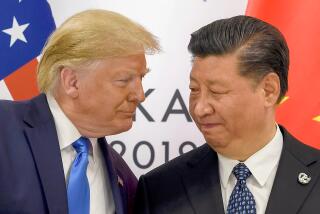Trade Deficit Up 22% in July; Dow Plunges 67, Dollar Near Its Low : Economy: Some analysts and the White House downplay the report, but others say growth is threatened.
- Share via
The U.S. trade deficit soared in July, the government said Tuesday in a report that pushed the dollar toward its record low against the Japanese yen and triggered a broad slide in stock prices, with the Dow Jones industrials posting their worst loss in six months.
The overall trade imbalance, including goods and services, jumped 22% from the previous month to $11 billion, the Commerce Department said.
The culprit was the second-worst monthly U.S. merchandise deficit on record--$15.7 billion--which was exceeded only by the record $15.9-billion shortfall in December, 1985, the agency said. U.S. trade in services showed a $4.7-billion surplus in July.
Some economists and the Clinton Administration cautioned against reading too much bad news into one month’s report. But other analysts, noting that the U.S. trade deficit is a chronic problem, said the latest figures do not bode well for continued U.S. economic growth.
Financial markets, already worried about the economy’s staying power and fading hopes for a U.S.-Japan agreement to fix the trade imbalance, were rattled by the report.
The stock market took the data particularly hard amid fears that the trade gap will prompt the Federal Reserve Board to raise interest rates yet again later this month to protect the dollar’s value, analysts said.
“There already was a bearish sentiment that was building” in the markets, which the trade report exacerbated, said Charlie Okada, executive vice president and currency trading manager at Sanwa Bank in Los Angeles.
The dollar was quoted at 97.65 yen in late New York trading, down from 98.53 on Monday and its lowest U.S. close since hitting a post-World War II nadir of 97.50 on July 12.
The Dow Jones average of 30 industrial stocks--which Thursday climbed to within 50 points of the 4,000 level--plunged 67.63 to 3,869.09, its worst daily decline since losing 72.27 on March 30.
The average’s slide also triggered the New York Stock Exchange’s “circuit breakers,” or trading restrictions designed to curb the market’s volatility, late in the session. Losers swamped gainers on the Big Board by nearly 4 to 1.
Bond prices also fell and their yields rose, but the damage wasn’t nearly as severe as in stocks. The Treasury’s bellwether 30-year bond lost less than 0.25 point, or $2.50 for every $1,000 in face value, and its yield edged up to 7.77% from 7.75% on Monday.
Once again, the United States’ biggest trade gap came with Japan, a deficit of $5.7 billion--the worst showing since March.
The shortfall with Japan came at a sensitive time, because negotiators for both nations are meeting this week in a bid to resolve trade disputes before a Sept. 30 deadline, after which the Clinton Administration could impose trade sanctions against Japan.
Indeed, U.S. exporters used Tuesday’s report to press Japan to further open its doors to U.S. goods.
The July figures “are a clear signal” that Japan “must take action to open its market to imports,” Andrew H. Card, president of the American Automobile Manufacturers Assn., a trade group for the Big Three car makers, said in a statement.
Commerce Secretary Ronald H. Brown said the July report was “not indicative of the economy’s long-term trend,” because it included a sharp drop in exports of U.S. commercial aircraft, whose sales tend to vary widely from month to month, and because July’s imports reflected oil prices that have since declined.
Many economists agree that U.S. trade is suffering because the nation’s growing economy is lifting Americans’ demand for imports, while many of its major trading partners are still struggling to emerge from recession--limiting their purchases of U.S. goods and services.
The U.S. trade deficit should be helped in the months ahead as the economies of Japan and Europe grow stronger, analysts said.
Josh Feinman, a global markets economist at Bankers Trust New York Corp., said the July trade figures were “consistent” with other recent reports indicating that the American economic expansion is slowing down.
“The wider trade deficit does suggest that the international sector is going to be a drag” on the U.S. economy, Feinman said. That might actually preclude the Federal Reserve from raising interest rates, he added.
For the first seven months of 1994, the U.S. trade deficit is running at an annual rate of $145.8 billion. That puts the nation on track to achieve its worst merchandise deficit since a record $152.1 billion imbalance in 1987.
U.S. Trade Deficit
In billions of dollars:
July 1994: $11
Source: Commerce Department
*
Times wire services were used in compiling this report.
STOCKS SLUMP: Slide is broad. D3
MARKET BEAT: Another 1987? D3
More to Read
Inside the business of entertainment
The Wide Shot brings you news, analysis and insights on everything from streaming wars to production — and what it all means for the future.
You may occasionally receive promotional content from the Los Angeles Times.











